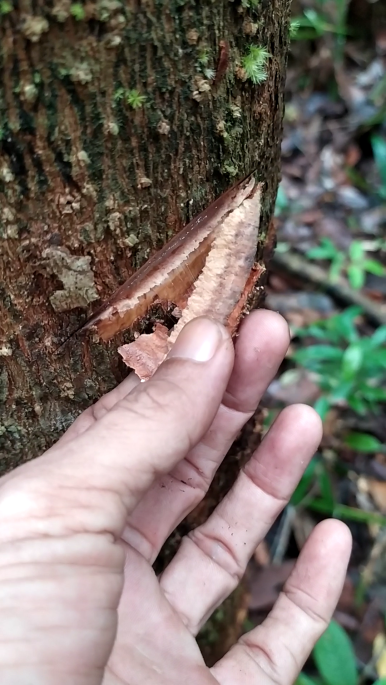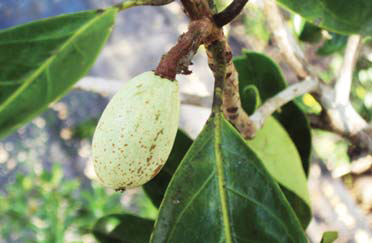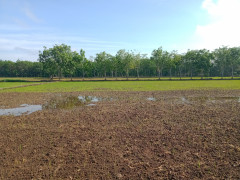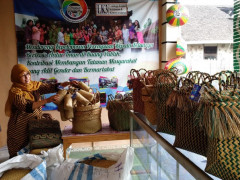A Silver Lining to Restoration in Concession Areas
By ZamzamiGemor: Peat Plants with a Multitude of Benefits

The peat ecosystem in Kalimantan has flora diversity that not only plays an ecological role but has also become a source of livelihood for the surrounding community. One of the plant species in the peat ecosystem is Gemor (Nothaphoebe coriacea), a peat swamp native hardwood plant that produces bark that could be sold by the community. Unfortunately, the declining population of this species in its natural habitat is a threat that should be a concern for all parties.
Gemor is an endemic plant that thrives in the Kalimantan peat swamp area. This plant is generally found in relatively dense and wet forested areas or on galeget soil, a term commonly used by the Dayak Ngaju people.
Aswin Usup, Lecturer at the Faculty of Agriculture and Head of the Institute for Research and Community Service (LPPM) at Universitas Palangka Raya, told Pantau Gambut that this plant, that could grow to an average height of 10-15 meters is very rare in the upstream areas and is difficult to grow in barren and forestless areas.
Gemor is one of the paludiculture plants' species that was developed in order to restore peat ecosystem sustainability while considering the surrounding community’s interest. At least two Gemor species are commonly used by the Dayak Ngaju people in Central Kalimantan, namely: red Gemor (Nothaphoebe Ciriacea Koserm), which has a yellowish red color after being peeled, and white Gemor (Nothaphoebe cf Umbelliflora) which has a white coloring on its bark.
According to the Banjarbaru Forestry Research Center, the Gemor bark in Kalimantan is mainly produced on the Central Kalimantan Province. Gemor is distributed in the following district in Central Kalimantan: Pulang Pisau, Kapuas, East Kotawaringin, South Barito and Katingan.
What are the Benefits of Gemor?
Gemor is a non-timber forest product (NTFP) that is beneficial for humans. The bark is known to have immunity-boosting properties, that could be used as antivirus and antioxidant to detoxify, and this plant even has active natural insecticide ingredients that are useful for eradicating mosquitoes. The Gemor plant seed also has beneficial properties, which are currently being studied by the LHK Research and Development Center in Banjarbaru, South Kalimantan. The results of this study indicate that Gemor seeds contain flavonoids, a substance that could be used to capture free radicals or function as natural antioxidants.
In addition to its benefit as an herbal plant, Aswin also said that Gemor is ecologically beneficial for peat swamps because this plant can absorb large amounts of aluminum and iron through its bark and leaves. Therefore, the Gemor plant is able to control the toxic elements in the peat soil, which allows other plant species to grow in the surrounding area. Once thriving, Gemor is difficult to burn because of its branch structure and its thick and slimy bark.
From an economic perspective, the people in Central Kalimantan have been harvesting Gemor from the forest since 1970. They only harvest Gemor bark to sell to the collectors, and never process it for their own use. What they know is that after being sold, the Gemor bark will be redistributed to a number of industries to be processed as raw material for a number of products. They are used as material for producing insect repellent, incense, and as raw materials for adhesives/glues. To this date there has been no assistance, either from the institutions or the government, to create additional value from the Gemor plant.
The selling price for Gemor bark is quite high, making Gemor collection an attractive and lucrative business, especially for the community in Katingan District. Currently, the price of wet/unprocessed Gemor bark in the international market is approximately USD 231-385 per ton. At the local collectors’ level in Central Kalimantan, the price of dry Gemor bark is approximately Rp 10,000-14,000 per kg, said Andy Liany, a natural Gemor collector from Katingan District. "If it is already processed in powder form, the price will reach Rp 40,000-50,000," Andy added.
Before becoming a forest Gemor collector, Andy, like any other Katingan resident, used the forest as his primary source of livelihood, which at that time meant working as a logger. Even before the village was included as part of the Sebangau National Park (TNS) area, the Katingan area has produced ironwood, meranti, and other forest products, such as rattan. Since the prohibition to harvest wood without having HPH and HTI permits, the residents have shifted to other forest products such as rattan, rubber, pantung, and also Gemor.
To produce good Gemor bark, the plant is harvested after 5-10 years and has an average diameter of 10 cm. Due to the difficulty, collectors rarely took the bark from a large tree branch. Gemor harvesters will dry out the bark and sell them at the village or sub-district market, at a price determined by the buyer/collector.
Decline in Natural Habitat
Gemor bark is typically harvested by cutting down the Gemor trees using a pickaxe or ax. When the Gemor tree has been logged, the tree bark is then chopped, then beaten using wood to make it easier to separate the bark from the branch. Afterward, the bark is gouged using a machete and stored in a lanjung to be carried home. At home, the wood is chopped into a length of about 5 cm and a width of 2-3 cm. The Gemor wood chopping is usually done by housewives with the help of their children. The chopped wood is then dried for 2-3 days. After drying, the chopped wood is then stored in sacks and is ready to be marketed.
The main problem about the declining Gemor tree habitat is the harvesting method, which requires a tree that has growing for years to be logged. As a result, Gemor trees are increasingly scarce and can only be found deep in the forest.
"Currently we are the only ones in Kamipang (Sub-District in Katingan) who are still harvesting Gemor," said Andy. He added that only a few people are still harvesting Gemor as their primary means of livelihood because of the effort it requires to find the Gemor.
Logging also affects the number of forest stands that are destroyed (because they are trampled by the Gemor tree) and are damaged when the trees are logged. The logging activities have also hindered the growth of Gemor plants due to the loss of seed-producing parent trees.
Sustainable harvesting techniques need to be introduced to the community to prevent further decline of the Gemor tree population. At the moment, there is no alternative technique for harvesting Gemor bark other than harvesting the trees as well. However, the community has implemented a selective logging system where only trees with a diameter of more than 20 cm are logged and only the upper part of the tree can be logged, leaving 50 cm of the tree intact.
Through selective harvesting, only part of the trees is harvested and the remaining tree stumps can continue growing. In addition, the 50 cm stump will grow into new shoots. This logging technique is known as the coppice system. This system will allow vegetative regeneration and the stump will mature to be harvested in the future.
Homework in Gemor product development
Future challenges in preserving Gemor that needs to be addressed are the sustainable cultivation techniques to carry out production activities without causing ecological losses. Aswin said that efforts to protect the area and local peat plants need to be performed.
"I think protection of the untouched area is essential, such as preserving village forests or customary forests or even protected forests and conservation forests," Aswin suggested.
Aswin added that the government needs to issue policies on sustainable harvesting systems to prevent Gemor from being extinct. The loss of Gemor will cause significant environmental changes because Gemor is a plant that grows under specific conditions and ecosystems.
Purwanto Budi S, from the Forestry Research and Development Center, Banjarbaru Forestry Research Center, said that the current challenge for Gemor conservation is the decreasing number of seed-producing parent trees required for natural regeneration; efforts to plant generative seeds are still lacking and the mass vegetative propagation technique is still suboptimal. Purwanto added that the conservation of peat swamp species is generally required for the parent trees to regenerate.
In addition, conservation efforts are facing challenges, namely the annual risk of fires during the dry season. Therefore, Gemor conservation efforts are not only carried out by planting new trees, but also by rewetting the peat ecosystem. The rewetting can be done by building canal blocks to increase the water level. In addition, it’s also important to put more effort into increasing the local community income by revitalizing their livelihoods to reduce the pressure on peat swamp forests.
In terms of policy, the Government needs to issue regulations to maintain the sustainability and continuity of plants living and growing in the peat ecosystem. All stakeholders working on peatlands need to comply with these regulations and work together to conserve the native peat species.
The Banjarbaru LHK Research and Development Center (BPPKB) have also built generative and vegetative nurseries for Gemor conservation. Efforts to restore and rehabilitate peatlands using native peat plant species such as balangeran, punak, tumih, geronggang, pelawan, and others are also carried out in the Tumbang Nusa Special Purpose Forest Area (KHDTK) and community areas.






